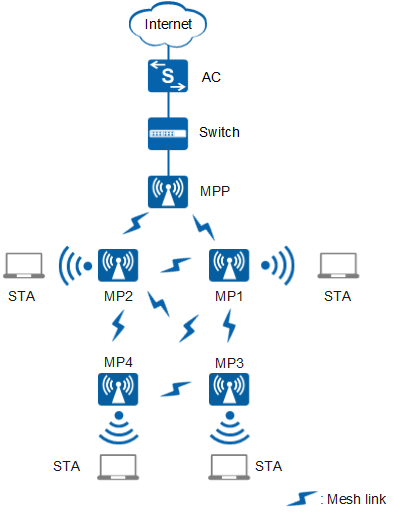Adding APs
Context
You can add APs in any of the following modes:
Importing APs offline: The APs' MAC addresses and serial numbers (SNs) are configured on an AC before APs go online. The AC starts to set up connections with the APs if the MAC addresses or SNs of the APs match the configured ones.
Configuring the AC to automatically discover an AP: The AP authentication mode is set to no authentication; alternatively, the AP authentication mode is set to MAC or SN authentication and the AP whitelist is configured on the AC. When an AP in the whitelist connects to the AC, the AC discovers the AP, and the AP goes online.
Manually confirming APs added to the list of unauthorized APs: The AP authentication mode is set to MAC or SN authentication, and the AP whitelist is configured on the AC. When an AP out of the whitelist connects to the AC, the AC adds the AP to the list of unauthorized APs. After the AP identity is confirmed, the AP can go online.
On a Mesh network, you can deploy an AP as an MPP or MP based on the location of the AP, as shown in Figure 1. Select a proper method to add APs on an AC according to actual situations.
- mesh-portal (MPP): an MP that connects to a WMN or another type of network. An MPP connects Mesh nodes to external networks. Each WMN has at least one MPP.

You are not advised to configure access VAPs on an MPP to ensure a high throughput.
- mesh-node (MP): a node that provides both mesh service and user access service. All nodes except MPPs on a WMN are MPs.
Procedure
- Add an AP offline.
- Configure the AC to automatically discover an AP.

If no AP name or AP group is configured for an automatically discovered AP on the AC, the configuration file of the AP name or AP group will not be generated in the AP view.
If an AP is deleted from the AC, the configuration in the AP view will be automatically deleted.
Set the AP authentication mode to no authentication.
- Run the system-view command to enter the system view.
- Run the wlan command to enter the WLAN view.
(Optional) Run the ap blacklist mac ap-mac1 [ to ap-mac2 ] command to add the AP to an AP blacklist.
By default, no AP is in an AP blacklist.
Run the ap auth-mode no-auth command to set the AP authentication mode to no authentication.
The default AP authentication mode is MAC address authentication. In the CloudCampus Solution scenario, for an AC working in NETCONF mode, the AP authentication mode is SN authentication.

The non-authentication mode brings security risks. You are advised to set the authentication mode to MAC address authentication or SN authentication, which is more secure.
Set the AP authentication mode to MAC address or SN authentication.
- Run the system-view command to enter the system view.
- Run the wlan command to enter the WLAN view.
(Optional) Run the ap blacklist mac ap-mac1 [ to ap-mac2 ] command to add the AP to an AP blacklist.
By default, no AP is in an AP blacklist.
Run the ap auth-mode { mac-auth | sn-auth } command to set the AP authentication mode to MAC address authentication or SN authentication.
The default AP authentication mode is MAC address authentication. In the CloudCampus Solution scenario, for an AC working in NETCONF mode, the AP authentication mode is SN authentication.
- Configure the AP whitelist.
Run the ap whitelist mac ap-mac1 [ to ap-mac2 ] command to add the AP with the specified MAC address to the whitelist if the AP authentication mode is set to MAC address authentication.
By default, no MAC address is added to the AP whitelist.
Run the ap whitelist sn ap-sn1 [ to ap-sn2 ] command to add the AP with the specified SN to the whitelist if the AP authentication mode is set to SN authentication.
By default, no SN is added to the AP whitelist.
- Manually confirm the AP added to the list of unauthorized APs.
